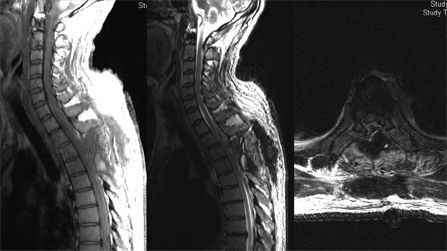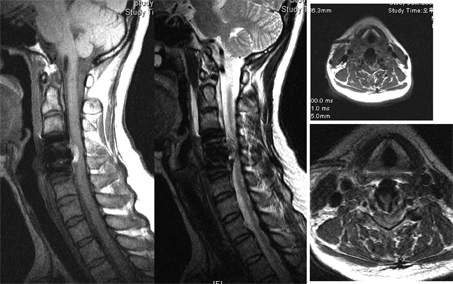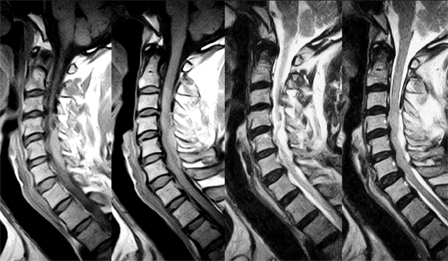Postoperative Spinal Epidural Hematoma: Risk Factor and Clinical Outcome
- Affiliations
-
- 1Department of Neurosurgery, Yonsei University College of Medicine, Seoul, Korea. imdrshin@yumc.yonsei.ac.kr
- KMID: 1715850
- DOI: http://doi.org/10.3349/ymj.2006.47.3.326
Abstract
- We report a series of epidural hematomas which cause neurologic deterioration after spinal surgery, and have taken risk factors and prognostic factors into consideration. We retrospectively reviewed the database of 3720 cases of spine operation in a single institute over 7 years (1998 April-2005 July). Nine patients who demonstrated neurologic deterioration after surgery and required surgical decompression were identified. Factors postulated to increase the postoperative epidural hematoma and to improve neurologic outcome were investigated. The incidence of postoperative epidural hematoma was 0.24%. Operation sites were cervical 3 cases, thoracic 2 cases, and lumbar 4 cases. Their original diagnoses were tumor 3 cases, cervical stenosis 2 cases, lumbar stenosis 3 cases and herniated lumbar disc 1case. The symptoms of epidural hematomas were neurologic deterioration and pain. After decompression, clinical outcome revealed complete recovery in 3 cases (33.3%), incomplete recovery in 5 cases (55.6%) and no change in 1 case (11.1%). Factors increasing the risk of postoperative epidural hematoma were coagulopathy from medical illness or anticoagulation therapy (4 cases, 44.4%) and highly vascularized tumor (3 cases, 33.3%). The time interval to evacuation of complete recovery group (29.3 hours) was shorter than incomplete recovery group (66.3 hours). Patients with coagulopathy and highly vascularized tumor were more vulnerable to spinal epidural hematoma. The postoperative outcome was related to the preoperative neurological deficit and the time interval to the decompression.
MeSH Terms
Figure
Cited by 4 articles
-
Why Cannot Suction Drains Prevent Postoperative Spinal Epidural Hematoma?
Dong Ki Ahn, Won Shik Shin, Jin Woo Kim, Seong Min Yi
Clin Orthop Surg. 2016;8(4):407-411. doi: 10.4055/cios.2016.8.4.407.Can We Prevent a Postoperative Spinal Epidural Hematoma by Using Larger Diameter Suction Drains?
Dong Ki Ahn, Jin Hak Kim, Byung Kwon Chang, Jae Il Lee
Clin Orthop Surg. 2016;8(1):78-83. doi: 10.4055/cios.2016.8.1.78.Neurological Complications of Posterior Spinal Surgery: Incidence and Clinical Features
Dong Ki Ahn, Jung Soo Lee, Won Shik Shin, Seong Min Yi, Ki Hyuk Koo
J Korean Soc Spine Surg. 2018;25(1):1-8. doi: 10.4184/jkss.2018.25.1.1.Cervical Spinal Epidural Hematoma Following Cervical Posterior Laminoforaminotomy
Jeong Hoon Choi, Jin-Sung Kim, Sang-Ho Lee
J Korean Neurosurg Soc. 2013;53(2):125-128. doi: 10.3340/jkns.2013.53.2.125.
Reference
-
1. Uribe J, Moza K, Jimenez O, Green B, Levi AD. Delayed postoperative spinal epidural hematomas. Spine J. 2003. 3:125–129.2. Kou J, Fischgrund J, Biddinger A, Herkowitz H. Risk factors for spinal epidural hematoma after spinal surgery. Spine. 2002. 27:1670–1673.3. Johnston RA. The management of acute spinal cord compression. J Neurol Neurosurg Psychiatry. 1993. 56:1046–1054.4. Foo D, Rossier AB. Preoperative neurological status in predicting surgical outcome of spinal epidural hematomas. Surg Neurol. 1981. 15:389–401.5. Scavarda D, Peruzzi P, Bazin A, Scherpereel B, Gomis P, Graftieaux JP, et al. Postoperative spinal extradural hematomas. 14 cases. Neurochirurgie. 1997. 43:220–227.6. Lawton MT, Porter RW, Heiserman JE, Jacobowitz R, Sonntag VK, Dickman CA. Surgical management of spinal epidural hematoma: relationship between surgical timing and neurological outcome. J Neurosurg. 1995. 83:1–7.7. Yonenobu K, Hosono N, Iwasaki M, Asano M, Ono K. Neurologic complications of surgery for cervical compression myelopathy. Spine. 1991. 16:1277–1282.8. Groen RJ, Ponssen H. The spontaneous spinal epidural hematoma. A study of the etiology. J Neurol Sci. 1990. 98:121–138.9. Boukobza M, Guichard JP, Boissonet M, George B, Reizine D, Gelbert F, et al. Spinal epidural haematoma: report of 11 cases and review of the literature. Neuroradiology. 1994. 36:456–459.10. Bernsen PL, Haan J, Vielvoye GJ, Peerlinck KM. Spinal epidural hematoma visualized by magnetic resonance imaging. Neuroradiology. 1988. 30:280.11. Rothfus WE, Chedid MK, Deeb ZL, Abla AA, Maroon JC, Sherman RL. MR imaging in the diagnosis of spontaneous spinal epidural hematomas. J Comput Assist Tomogr. 1987. 11:851–854.12. Nawashiro H, Higo R. Contrast enhancement of a hyperacute spontaneous spinal epidural hematoma. AJNR Am J Neuroradiol. 2001. 22:1445.13. Laglia AG, Eisenberg RL, Weinstein PR, Mani RL. Spinal epidural hematoma after lumbar puncture in liver disease. Ann Intern Med. 1978. 88:515–516.14. Delamarter RB, Sherman J, Carr JB. Pathophysiology of spinal cord injury. Recovery after immediate and delayed decompression. J Bone Joint Surg Am. 1995. 77:1042–1049.15. Vandermeulen EP, Van Aken H, Vermylen J. Anticoagulants and spinal-epidural anesthesia. Anesth Analg. 1994. 79:1165–1177.16. Beatty RM, Winston KR. Spontaneous cervical epidural hematoma. A consideration of etiology. J Neurosurg. 1984. 61:143–148.17. Cooper DW. Spontaneous spinal epidural hematoma. Case report. J Neurosurg. 1967. 26:343–345.18. Dickman CA, Shedd SA, Spetzler RF, Shetter AG, Sonntag VK. Spinal epidural hematoma associated with epidural anesthesia: complications of systemic heparinization in patients receiving peripheral vascular thrombolytic therapy. Anesthesiology. 1990. 72:947–950.19. Payne DH, Fischgrund JS, Herkowitz HN, Barry RL, Kurz LT, Montgomery DM. Efficacy of closed wound suction drainage after single-level lumbar laminectomy. J Spinal Disord. 1996. 9:401–403.20. Dolan EJ, Tator CH, Endrenyi L. The value of decompression for acute experimental spinal cord compression injury. J Neurosurg. 1980. 53:749–755.
- Full Text Links
- Actions
-
Cited
- CITED
-
- Close
- Share
- Similar articles
-
- Spontaneous Spinal Epidural Hemorrhage
- Thoracolumbar Epidural Hematoma Complicated by Cauda Equina Syndrome : Complication of Systemic Heparinization Following Epidural Anesthesia: A case report
- Hemorrhagic Complication after Spine Surgery
- Spontaneous Lumbar Spinal Epidural Hematoma without Rist Factors: A Case Report
- Surgical Treatment of Spontaneous Spinal Epidural Hematoma: A Case Report





